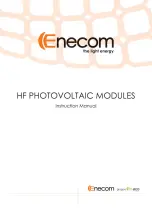
Solar Panels
8
prevent the maximum amount of energy passing from the panel into the battery
during sunny conditions.
If used in a high current application, although there is no risk of overcharging the
battery, the charger may get hot, especially when solar radiation is very high. This
can be minimised by mounting the panel at less than its optimum Summer angle, or
even turning the panel to its Winter setting (see Sections 2 and 4).
The SP30, when connected to the CR3000, CR6 datalogger or the
PS150 series chargers, must
not
be used to charge a large external
battery, connected in parallel with the internal battery.
It is also important to note that the SP30R (with shunt regulator)
should
not
be connected to any of the power supply chargers or to
the rechargeable CR3000/CR6 charging circuit.
3.4 Using solar panels with the CH150 and CH200 chargers
Any of the solar panels which do not have built-in or secondary regulators can be
used with the CH150 and CH200, with the exception of the SP100 which requires
a high current charger.
Please refer to the manual for these chargers which can accommodate two charge
sources, larger panels and larger batteries.
3.5 Using solar panels with Morningstar regulators
SP60 and SP100 panels will often be supplied with high current regulators. Please
refer to the instruction supplied with those regulators. Please note that the
quiescent consumption of the regulator may be quite high, e.g. 8-10 mA. Please
note the fuse warning below.
4. Optimum Battery Size
The batteries fitted inside the rechargeable CR3000, and the ‘PS’ power supplies
and the BP7 have a capacity of 7Ah. These batteries are suitable for operation with
solar panels at most sites for many applications with slow to medium power
requirements.
However, the power consumption of a logging system can vary a great deal;
factors such as high logging frequencies, external sensors, communications
interfaces and multiplexers will all add to the power requirement. Very low
temperatures can also reduce the effective capacity of the battery and the
geographical location of the installation can greatly affect how much energy the
panel can capture.
It is essential to analyse all the power requirements and to try to arrive at a figure
for the total power consumed over a daily period, normally estimated in ampère-
hours. The following general rules can then be used to estimate the size of panel
and battery capacity required for reliable operation:
When the solar panel is set at the optimum winter angle (latitude plus 15
degrees from horizontal), the average power it can capture in mid-winter
should be equal to your estimate of the average power needed by the data-
logger. Please contact Campbell Scientific for further details of the efficiency
NOTE





































